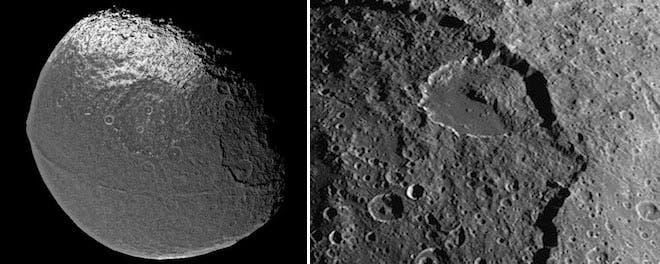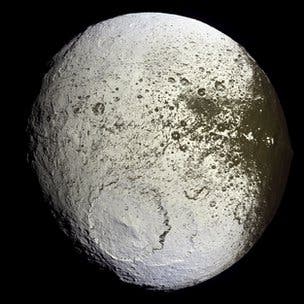
A giant landslide on Iapetus reaches halfway across a 75-mile (120 kilometer) impact crater.(c) NASA/JPL/Space Science Institute
Planetary scientist Kelsi Singer initially studied satellite photographs of Saturn’s icy moon Iapetus’ surface looking for stress fractures in the moon’s ice, what she found in process however was far more interesting. Huge landslides, stretching across tens of miles across the moon’s surface were observed, not in one, but multiple locations, hinting this is a common phenomenon on the ice covered satellite. Very broad landslides have been recorded on Earth as well, although nowhere near this magnitude, and the study at hand might serve to hint towards the mechanisms involved in these natural formations.
Iapetus is one of the oddest cosmic bodies in the solar system. Barren, cold and mostly covered in very thick ice, the satellite presents a highly rugged terrain, with ridges that can reach as much as 12 miles in height or two times the altitude of Mount Everest. Like the ubiquitous yin-yang, the moon’s surface is half covered in darkness, while the other side is much brighter. Moreover, it has the most eccentric geometry out of all the solar system’s planets or moons, made evident by a mountainous ridge that bulges out at its equator – this is why it’s commonly referred to as the “walnut”.
Because of this incredibly odd topography, Iapetus has more giant landslides than any Solar System body other than Mars. So far, evidence of 30 massive landslides have been found – 17 along crater walls and 13 along the giant equatorial ridge, however even more might be encountered if an exhaustive observation were to be performed.
“Not only is the moon out-of-round, but the giant impact basins are very deep, and there’s this great mountain ridge that’s 20km (12 miles) high, far higher than Mount Everest,” explained Prof William McKinnon, also from Washington University,.
“So there’s a lot of topography and it’s just sitting around, and then, from time to time, it gives way.”
The icy landslides are similar to long-runout landslides on Earth known as sturzstroms (German for fallstreams) – massive landslides can move up 20 to 30 times the height they fall from. Typically, on Earth, conventional landslides only travel around two times the height they fall from.
Apparently, the mechanism that governs the formation of these massive landslides, on Iapetus or here on Earth, has yet to reach an consensus from scientists. Various theories have been suggested from riding on a cushion of trapped air, to sliding on groundwater or mud, to sliding on ice, or slipping caused by strong acoustic vibrations.
According to Singer, a graduate student in earth and planetary sciences at Washington University in St. Louis and lead author of the paper presently discussed, the massive landslides most likely occur by frictional heating of the ice. Since it doesn’t have an atmosphere, the coefficient of friction – a measure of how much the slip-sliding of material in a landslide tends to slow it down – on Iapetus is far lower than expected for ice.
Despite the ice on Iapetus is as a solid as rock, scientists hypothesize that tiny contact points between bits of ice debris in such a landslide may heat up considerably,leading to a thin layer of ice crystals that melts. This might cause the huge landslides on Saturn’s icy moon, but could also serve to explain how sturzstroms form on Earth.
“The landslides on Iapetus are a planet-scale experiment that we cannot do in a laboratory or observe on Earth,” Ms Singer said.
“They give us examples of giant landslides in ice, instead of rock, with a different gravity, and no atmosphere. So any theory of long-runout landslides on Earth must also work for avalanches on Iapetus.”
The findings were reported in the journal Nature Geoscience.










